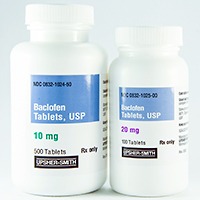-
Adopt
-
Veterinary Care
Services
Client Information
- What to Expect – Angell Boston
- Client Rights and Responsibilities
- Payments / Financial Assistance
- Pharmacy
- Client Policies
- Our Doctors
- Grief Support / Counseling
- Directions and Parking
- Helpful “How-to” Pet Care
Online Payments
Referrals
- Referral Forms/Contact
- Direct Connect
- Referring Veterinarian Portal
- Clinical Articles
- Partners in Care Newsletter
CE, Internships & Alumni Info
CE Seminar Schedule
Emergency: Boston
Emergency: Waltham
Poison Control Hotline
-
Programs & Resources
- Careers
-
Donate Now

By Callie E. Cazlan, DVM (Emergency Veterinarian)![]()
angell.org/emergency
emergency@angell.org
617-541-5139
March 2022
Introduction
The first case report of baclofen toxicosis came from Tufts University School of Veterinary Medicine in 1998, where a 5-year-old mixed breed dog presented for acute onset of ataxia and vocalization after presumably ingesting 4 to 6 mg/kg of baclofen. At the presentation, she was stuporous, hypothermic, and hypertensive. With decontamination and supportive therapy, the dog survived to discharge.4 Since this initial case report, there have been a number of case reports and case series detailing the expected clinical signs and the suggested therapies for this ingestion. The key to patient survival with this toxin is prompt recognition of the clinical signs associated with ingestion leading to rapid and appropriate interventions. The goal of this article is to familiarize the clinician with these aspects.
supportive therapy, the dog survived to discharge.4 Since this initial case report, there have been a number of case reports and case series detailing the expected clinical signs and the suggested therapies for this ingestion. The key to patient survival with this toxin is prompt recognition of the clinical signs associated with ingestion leading to rapid and appropriate interventions. The goal of this article is to familiarize the clinician with these aspects.
What is Baclofen?
Baclofen is a centrally acting muscle relaxant used in people for muscle pain and spasticity associated with multiple sclerosis and spinal injuries. While baclofen can be used extra-label in dogs to treat urinary retention (1-2 mg/kg orally TID), doses in dogs as low as 0.7 mg/kg have been reported to cause clinical signs of toxicity.3 While fatalities have been reported in doses as low as 2.3 mg/kg, the patient in that report did not receive medical attention until several hours after ingestion. Sometimes owners know that their dog chewed open their bottle of baclofen, making the diagnosis more obvious. Other times, ingestion is not known at the time of presentation. Therefore it is important to be familiar with the clinical  signs associated with baclofen toxicity (Table 1) so owners can be questioned about its presence in the home at the time of admission.
signs associated with baclofen toxicity (Table 1) so owners can be questioned about its presence in the home at the time of admission.
Clinical Course
Baclofen toxicity has been reported to manifest anywhere from 30 minutes after ingestion to a few hours.2 Toxicity has been reported primarily in dogs but will also affect cats.3 In a retrospective study of 128 dogs and five cats, the most common clinical signs seen are central nervous system depression (42.9%), vomiting (36.1%), ataxia (33.1%), and vocalization (30.1%). More sinister (yet rarer) manifestations of this toxicity can include seizures (6.8%) and respiratory depression (6.0%). In any patient showing a rapid onset of these signs, baclofen toxicity should be suspected, and household members should be questioned about using this drug in the home. Since symptoms can come on rapidly and potentially have lethal manifestations (i.e., respiratory depression and arrest), it is paramount to quickly identify any possible ingestion to guide emergent diagnostics and therapies. A summary of clinical signs can be found in Table 1.
| Table 1- Most common clinical signs associated with baclofen toxicity |
| CNS depression
Ataxia Vocalization Coma Vomiting/Diarrhea Hypersalivation Bradycardia Tremors Miosis Seizures Respiratory depression Urinary incontinence Tachypnea Arrhythmias Hyperthermia Hyper/hypotension Hypernatremia |
Treatment
Literature for specific treatment protocols is not readily available to date. However, one can draw a few important conclusions from our reports. The first step to any potential toxicosis is going to be decontamination. Emesis can be considered if a patient is seen before the onset of neurologic depression. Additionally, if needed, single-dose activated charcoal with a cathartic is recommended using an orogastric tube.2 Cyproheptadine hydrochloride (a serotonin agonist) has also been reported to reduce the vocalization or disorientation seen in some animals (ASPCA APCC Database: Unpublished data, 1994-2004). This can be used at 1.1 mg/kg orally or rectally as needed. Diazepam (0.5-1 mg/kg slowly intravenous) is recommended for patients experiencing seizure activity. Propofol may be considered for refractory cases.2
Baclofen is both protein-bound and renally excreted. This allows us to use fluid diuresis to enhance elimination and potentially decrease the duration of clinical signs. Additionally, intralipid emulsion (ILE) therapy has been shown to greatly increase patient awareness and shorten the course of clinical signs bearing in mind that ILE therapy may counteract the effects of other lipophilic drugs. One case report was of a cat whose mentation improved in one hour after receiving standard-dose ILE therapy following ingestion of 10 mg/kg baclofen.5 In the author’s experience ILE therapy has dramatically shortened the clinical course of this particular toxicosis and should be considered an adjunct to other therapies in every case.
It is also important to recognize respiratory depression and even the possibility of arrest in severe toxicities. Monitoring respiratory rate and effort and venous blood gas parameters may help identify patients who require endotracheal intubation and positive pressure mechanical ventilator support or extracorporeal therapy. In one case report, a 9-month-old, spayed female, Doberman Pinscher ingested 20 mg/kg of baclofen and presented with signs of coma and severe respiratory depression. The patient was placed on positive pressure ventilation and received one session of hemodialysis.6 Within four hours, the patient was able to be weaned from the ventilator and regained full neurologic function. Extracorporeal therapy such as hemodialysis +/- hemoperfusion and total plasma exchange can be effective adjuncts to severe cases. Another study showed that combined hemodialysis/hemoperfusion shortened the baclofen serum half-life from 5 hours to 1.5 hours in the initial 2 hours of treatment.1 However, this may be cost-prohibitive or not as widely available as ILE. Furthermore, given the relatively short half-life of the drug, extracorporeal therapy may not provide significant therapeutic benefit. With the combination of respiratory depression and CNS depression, it is also essential to monitor for signs of aspiration pneumonia. Chest radiographs should be considered, and antibiotic therapy initiated if this is suspected.
Hypoglycemia, hypokalemia, and elevated creatinine have also been reported with baclofen toxicity. Obtaining a baseline serum chemistry and electrolyte values is recommended to guide support as necessary.
Patients with baclofen toxicity should be monitored closely in an intensive care setting. Monitoring of vital parameters (heart rate, respiratory rate, temperature, and blood pressure) is recommended at regular intervals in addition to close monitoring of neurologic status. Patients can lose respiratory drive and gag reflex very quickly so it is important to be aware of these possibilities so one can intervene with appropriate supportive measures (i.e. mechanical ventilation). The Modified Glasgow Coma Scale may be considered to track a patients CNS changes.
Prognosis
Prognosis is considered good in cases treated with timely and appropriate care. While severe cases can take several days to resolve, residual central nervous signs are not reported following recovery. Patients with seizures may have a more guarded prognosis with a potential for organ dysfunction and the development of an ongoing epileptic seizure disorder.
References
-
- Scott NE, Francey T, Jandrey K. Baclofen intoxication in a dog successfully treated with hemodialysis and hemoperfusion coupled with intensive supportive care. J Veter Emer Crit 2007;17:191–196.
- Wismer T. Baclofen overdose in dogs. Veterinary Medicine 2004; 99(5):406–408.
- Khorzad R, Lee JA, Whelan M, et al. Baclofen toxicosis in dogs and cats: 145 cases (2004–2010). Journal of the American Veterinary Medical Association 2012;241:1059–1064.
- Hecht DV, Allenspach K. Presumptive Baclofen Intoxication in a Dog. J Veter Emer Crit 1998;8:49–54.
- Edwards P, Shihab N, Scott HW. Treatment of a case of feline baclofen toxicosis with intravenous lipid therapy. Vet rec case rep 2014;2.
- Torre DM, Labato MA, Rossi T, et al. Treatment of a dog with severe baclofen intoxication using hemodialysis and mechanical ventilation. Journal of Veterinary Emergency and Critical Care 2008;18:312–318.